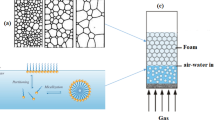Abstract
Apparent yield stress is a very useful rheological property which is important in determining the extent of mixing in xanthan fermentations as well as the suspending ability of the gum solutions. Using a previously developed stress relaxation technique, three commercial products, one home-made product and one dehydrated-reconstituted fermentation broth (DRFB) were characterized in terms of the apparent yield stressτ y of solutions containing different polymer concentrations and when mono and divalent salts or sucrose were added and also when exposing the samples to heat treatment in the case of DRFB. Sodium, potassium, calcium, magnesium, acetate, pyruvate, the mean molecular weight (MMW) and the molecular weight distribution (MWD) were determined. Although the four products showed differences in their chemical characteristics, the pyruvic acid content and the mean molecular weight played the main role in determining the yield stress patterns. With no salt added, the slope of theτ y vs gum concentration plot was a strong and inverse function of the pyruvate content. With NaCl 0.5%, the mentioned slope correlated linearly with the MMW. The three commercial xanthans showed very similar MWD. Xanthan broths showed an exponential, rather than a linear (as it was the case for end-products) function ofτ y in terms of xanthan concentration. No significative differences were found in τy depending on the type of salt. Sucrose decreasedτ y and this effect was more pronounced in DRFB than in a solution of a commercial xanthan.
Similar content being viewed by others
References
Galindo, E.: Xanthan gum: a microbial polysaccharide obtained from sucrose, having extraordinary properties and a variety of applications. GEPLACEA Bulletin 5 (September) (1988) 1–8
Elson, T. P.;Cheesman, D. J.;Nienow, A. W.: X-Ray studies of cavern sizes and mixing performance with fluids possesing a yield stress. Chem. Eng. Sci. 41 (1986) 2555–2562
Hanks, R.;Ricks, B.: Laminar-turbulent transition in flow of pseudoplastic fluids with yield stress. J. Hidronautics 8 (1974) 163–166
Darby, R.; Melson J.: How to predict the friction factor for flow of Bingham plastics. Chem Eng (Dec) (1981) 59–61
Steff, J.;Morgan, R.: Pipeline design and pump selection for non-Newtonian fluid foods. Food Technol. 40 (1986) 78–85
Hannote, M.;Flores, P.;Torres, L.;Galindo, E.: Apparent yield stress estimation in xanthan gum solutions and fermentation broths by a low-cost viscosimeter. The Chem. Eng. J. 45 (1991) B49-B56
Galindo, E.; Salcedo, G.; Ramírez, M. E.: Preservation ofXanthomonas campestris on agar slopes: Effects on xanthan production. Appl. Microbiol. Biotechnol. (1994) 634–637
Torres, L. G.;Brito, E.;Galindo, E.;Choplin, L.: Viscous behaviour of xanthan aqueous solutions from a variant strain ofXanthomonas campestris. J. Ferment. Bioeng. 75 (1993) 58–64
Galindo, E.;Torrestiana, B.;García-Rejón, A.: Rheological characterization of xanthan fermentation broths and their reconstituted solutions, Biopr. Eng. 4 (1989) 113–118
Montes, A. L.: Bromatologia. Vol I. Universitaria de Buenos Aires (Edit.), (1966) Argentina
Mc Comb, E. A.;Mc Cready, R. M.: Determination of acetyl in pectin and acetylated carbohydrate polymers. Hydroxamic acid reaction. Anal. Chem. 29 (1957) 819–821
Hadjivassiliou, A. A.;Rieder, S. V.: The enzymatic assay of pyruvic and lactic acid. A definitive procedure. Clin. Chim. Acta 19 (1968) 357–361
Herbst, H.;Schumpe, A.;Deckwer, W.-D.: Xanthan production in stirred tank fermentors: Oxygen transfer and scale-up. Chem. Eng. Technol. 15 (1992) 425–434
Graham, H. D.: Microdetermination of Keltrol (xanthan gum) J. Dairy Sci. 54 (1971) 1622–1628
Sanford, P. A.;Pittsley, J. E.;Knutson, C. A.;Watson, P. R.;Cadmus, M. C.;Jeanes, A.: Variation inXanthomonas campestris NRRL B-1459: Characterization of xanthan products of differing pyruvic acid content, In: Sanford P. A. and Laskin, A. (Eds.) ACS Symp. Ser: Extracellular Microbial Polysaccharides, vol. 45, (1977) American Chemical Society, Washington, D.C., pp. 192–209
Peters, H-U.;Suh, I. S.;Deckwer, W.-D.: Modeling of batchwise xanthan production. Can J. Chem. Eng. 70 (1992) 742–750
Flores, F.;Torres, L. G.;Galindo, E.: Effect of the dissolved oxygen tension during cultivation ofX. campestris on the production and quality of xanthan gum. J. Biotechnol. 34 (1994) 165–173
Author information
Authors and Affiliations
Additional information
This work was supported in part by CONACyT (grant 1020-N9111). We are grateful to S. Rodríguez for the atomic absorption determinations. We thank G. Araiza for someτ y measurements and N. Zambrano for helping us with the pyruvate and acetate determinations. We especially thank L. Güereca for his valuable assistance and advise in developing the GPC technique and Prof. A. W. Nienow (University of Birmingham, U.K.) for kindly allowing us to use the Contraves 30 rheometer for the MMW estimation.
Rights and permissions
About this article
Cite this article
Torres, L.G., Flores, F. & Galindo, E. Apparent yield stress of xanthan solutions and broths. Bioprocess Engineering 12, 41–46 (1995). https://doi.org/10.1007/BF01112992
Received:
Issue Date:
DOI: https://doi.org/10.1007/BF01112992




